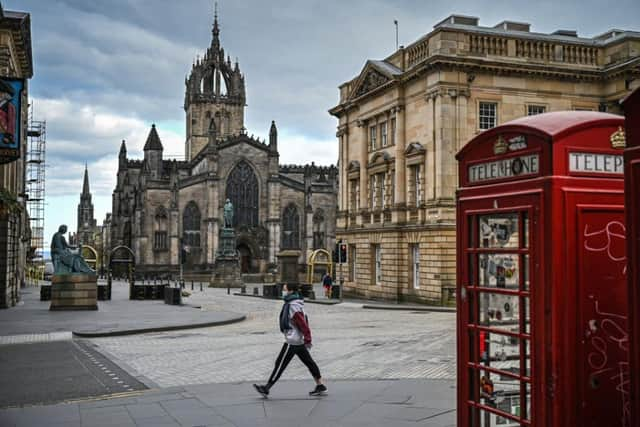Will Edinburgh go into lockdown? Capital and Lothians "under review" as infections rise - and how Covid cases compare across Scotland
and live on Freeview channel 276
Tougher lockdown measures have been reimposed around Glasgow and western parts of Scotland due to a recent rise in coronavirus cases.
First Minister Nicola Sturgeon announced the stricter rules on 1 September after 66 new positive tests were recorded in the NHS Greater Glasgow and Clyde area.
Advertisement
Hide AdAdvertisement
Hide AdSo will similar restrictions be imposed in Edinburgh, as coronavirus cases continue to increase?


Why was a local lockdown imposed?
Tougher restrictions were put in place in the Greater Glasgow and Clyde area after more than 130 new coronavirus cases were recorded in the space of two days.
Ms Sturgeon said that transmission mainly appeared to be occurring inside people’s homes and between households, rather than in pubs and restaurants.
In response to fears that more people will enter hospital and intensive care if cases continue to rise further, the Scottish Government made the decision to impose stricter rules in the area in regard to visiting households.
Advertisement
Hide AdAdvertisement
Hide AdRestrictions imposed on 2 September for the NHS Greater Glasgow and Clyde area mean that visiting other households is no longer allowed, with the rule applying to people living in Glasgow, West Dunbartonshire and East Renfrewshire.
Exceptions to the new rules were given for extended households that were established during lockdown, as well as on top of emergency circumstances or providing care to a vulnerable person. Such households include those who live alone, couples who do not reside together and parents who live alone with children under the age of 18.
The Scottish Government announced on Monday (14 September) evening that the restrictions on meeting in indoor household settings will remain in place for another week and will then be reviewed again, but they appear to be having an effect.
Tougher restrictions were also imposed in Aberdeen in early August, forcing all bars and restaurants to close, a five-mile travel ban to be reinstated, and the mixing of households to be banned. These measures have since been eased, with the travel limit and restrictions on indoor gatherings lifted on 24 August, followed by the reopening of hospitality businesses two days later on 26 August. Guidance for the city is now in line with the rest of Scotland.
Is Edinburgh at risk of local lockdown?
Advertisement
Hide AdAdvertisement
Hide AdWhile local lockdown restrictions have only been imposed in three council areas, Ms Sturgeon warned that similar measures could be extended to other parts if infection rates continue to rise.
The latest data from Public Health Scotland (PHS) shows that the rate of positive cases per 100,000 people in Edinburgh, as of 15 September, is currently 397.6.
By comparison, the current rate in Glasgow is significantly higher at 558.5 per 100,000 people, suggesting the capital is not yet at risk of having restrictions tightened.
Looking at the NHS Board areas, Edinburgh is within NHS Lothians, where the infection rate is currently 403.2 per 100,000 people.
Advertisement
Hide AdAdvertisement
Hide AdAgain, this is quite comfortably lower than in the NHS Greater Glasgow and Clyde area, which has a rate of 556.5.
Speaking at the coronavirus daily briefing on Tuesday (15 September), Ms Sturgeon said that restrictions in Edinburgh and the Lothians are under review following a spike in cases, adding that the government is montioring the numbers very closely.
Additional restrictions have not yet been introduced, with one of the main reasons being that “there wasn’t a particular driver” causing cases to increase, as there was in Greate Glasgow and Clyde.
However, while tougher lockdown restrictions may not yet be necessary in Edinburgh, Ms Sturgeon warned that the recent change to rules in three council areas should serve as a “wake-up call” for people to continue to follow the rules.
Advertisement
Hide AdAdvertisement
Hide AdSpeaking during First Minister’s questions in the Scottish Parliament earlier this month, she said: “We hope [the restrictions] will allow the spread to be contained at an early stage without the need for further measures later.
“They apply only in these three council areas right now, but I think they should be a wake-up call for all of us. If we let it, this virus will spread rapidly.
“The good news, though: if we all stick to some basic rules and continue to make some sacrifices, we can stop it.”
Which areas have the highest infection rates?
Tougher lockdown restrictions could be imposed in areas where the rate of infection is rising rapidly, as is the case in the NHS Greater Glasgow and Clyde area.
Advertisement
Hide AdAdvertisement
Hide AdListed are the Scottish NHS Boards with the current highest rates of coronavirus infections, based on the latest available data from Public Health Scotland.
The figures are based on results from NHS laboratories and UK government testing centres in Scotland as of 15 September. The infection rate is expressed as the rate of positive cases (cumulative) per 100,000 population, by NHS Board.
NHS Greater Glasgow and Clyde
Rate of positive cases per 100,000 population: 556.5
NHS Tayside
Rate of positive cases per 100,000 population: 530.1
NHS Lanarkshire
Rate of positive cases per 100,000 population: 517.6
NHS Forth Valley
Rate of positive cases per 100,000 population: 404.1
NHS Lothian
Rate of positive cases per 100,000 population: 403.2
NHS Ayrshire and Arran
Rate of positive cases per 100,000 population: 401.5
NHS Borders
Rate of positive cases per 100,000 population: 363.6
NHS Grampian
Rate of positive cases per 100,000 population: 345.9
NHS Fife
Rate of positive cases per 100,000 population: 280.8
NHS Shetland
Rate of positive cases per 100,000 population: 248.7
NHS Dumfries and Galloway
Rate of positive cases per 100,000 population: 223.7
NHS Highland
Rate of positive cases per 100,000 population: 155.7
NHS Orkney
Rate of positive cases per 100,000 population: 76.3
NHS Western Isles
Rate of positive cases per 100,000 population: 33.7
